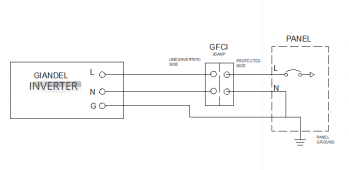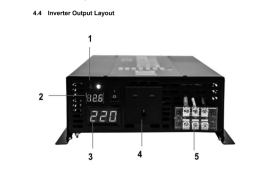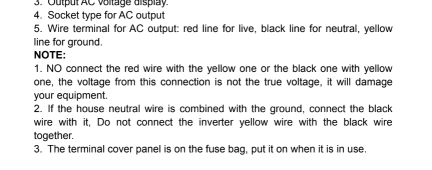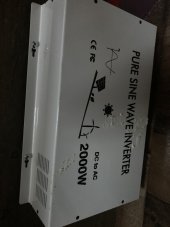Riverside0396
New Member
Hi,
This is my first ever solar system. Please go easy, I'm here to learn and am eager to receive advice
Background threads on the forum I've read:

 diysolarforum.com
diysolarforum.com

 diysolarforum.com
diysolarforum.com

 diysolarforum.com
diysolarforum.com
My system:
- Completely off-grid. No shore power, no utility, no generator.
- True earth ground is connected to DC bus negative, AC breaker ground bus and the inverter/MPPT/solar panel chassis.
- Mission Solar 425W x2 panels
- Victron Smart Solar 100/50 MPPT
- AmpereTime 24V 100Ah LiFePO4
- Giandel PS-3000KAR inverter
Same as mentioned in the other threads, Giandel is advising me that I should NOT create a neutral-ground bond. When I asked them if it's ok to do it after a GFCI device as mentioned in the other threads, they went unresponsive. So I don't have a way to clear ground faults. I am unable to find sub-$600 2kW-3kW discrete inverters for 24V batteries that bond neutral and ground or clearly allow me to.
So this has resulted in a floating neutral circuit and rendered my immense efforts with grounding rods and running 6AWG copper conductors somewhat sadly useless. I have added AFCI/GFCI protected outlet at the point of circuit entry after the breaker. My questions are:
- The polarity tester shows "open ground" and doesn't trip the GFCI outlet when I press the ground fault button. My understanding is that should connect hot and ground, resulting in an imbalance, and trip the outlet. What am I missing?
- Even with the AC circuit breaker off, the voltage detector detects voltage in the circuit. I suspect this is due to the floating neutral? Is that dangerous even if the hot wire is disconnected by the breaker? I am guessing not, but would be good to know.
- How can I truly test a ground fault? Do I have to rely on the "test" button on the AFCI/GFCI outlet?
- Lastly, how can I determine if it is safe to bond neutral and ground post a GFCI device like this image? (I'm thinking of getting a 12/3 inline GFCI extension cord and connecting that to the terminal block). What I don't understand is that doing this would result in a ground fault being routed to the neutral at the panel, so the breaker might trip, but doesn't it render the GFCI outlet (after the breaker) useless as it won't detect an imbalance?

This is my first ever solar system. Please go easy, I'm here to learn and am eager to receive advice
Background threads on the forum I've read:

Giandel NO Ground-Neutral Bonding
RE: Giandel advised - Ground/Neutral Bonding not supported - floating only - 24V / 3000W PSU Hi All, Giandel recently advised me they do NOT support bonding of Ground to Neutral with their 24V/3000W/PSU inverter. The Tesla charger wouldn't function along with other devices that did soft 5mA...

neutral-ground bonding giandel - how to interpret their advice?
I am using a Giandel inverter, PS-2200KAR 2200 W. I wired the inverter through an automatic transfer switch (GO Power! TS-30 amp) to a breaker panel. So it goes inverter & shore -> transfer switch -> panel I tried to wire USB-compatible outlets from this panel - without the outlet breaker on, I...

Giandel open ground again!
I am re-opening the pandora box on open ground Giandel inverters :) I have a 24v 3,000 watt Giandel pure sine wave inverter which is performing great. It is installed in a small shed setting where I have access to a real dedicated earth ground. This specific inverter only has a ground lug...
My system:
- Completely off-grid. No shore power, no utility, no generator.
- True earth ground is connected to DC bus negative, AC breaker ground bus and the inverter/MPPT/solar panel chassis.
- Mission Solar 425W x2 panels
- Victron Smart Solar 100/50 MPPT
- AmpereTime 24V 100Ah LiFePO4
- Giandel PS-3000KAR inverter
Same as mentioned in the other threads, Giandel is advising me that I should NOT create a neutral-ground bond. When I asked them if it's ok to do it after a GFCI device as mentioned in the other threads, they went unresponsive. So I don't have a way to clear ground faults. I am unable to find sub-$600 2kW-3kW discrete inverters for 24V batteries that bond neutral and ground or clearly allow me to.
So this has resulted in a floating neutral circuit and rendered my immense efforts with grounding rods and running 6AWG copper conductors somewhat sadly useless. I have added AFCI/GFCI protected outlet at the point of circuit entry after the breaker. My questions are:
- The polarity tester shows "open ground" and doesn't trip the GFCI outlet when I press the ground fault button. My understanding is that should connect hot and ground, resulting in an imbalance, and trip the outlet. What am I missing?
- Even with the AC circuit breaker off, the voltage detector detects voltage in the circuit. I suspect this is due to the floating neutral? Is that dangerous even if the hot wire is disconnected by the breaker? I am guessing not, but would be good to know.
- How can I truly test a ground fault? Do I have to rely on the "test" button on the AFCI/GFCI outlet?
- Lastly, how can I determine if it is safe to bond neutral and ground post a GFCI device like this image? (I'm thinking of getting a 12/3 inline GFCI extension cord and connecting that to the terminal block). What I don't understand is that doing this would result in a ground fault being routed to the neutral at the panel, so the breaker might trip, but doesn't it render the GFCI outlet (after the breaker) useless as it won't detect an imbalance?






